
Alsace is a cultural region and a territorial collectivity in eastern France, on the west bank of the upper Rhine next to Germany and Switzerland. In January 2021, it had a population of 1,919,745. Alsatian culture is characterized by a blend of German and French influences.

The Battle of Turckheim took place during the Franco-Dutch War that occurred on 5 January 1675 at a site between the towns of Colmar and Turckheim in Alsace. The French army, commanded by the Viscount of Turenne, defeated the armies of Austria and Brandenburg, led by Alexander von Bournonville and Frederick William, Elector of Brandenburg.
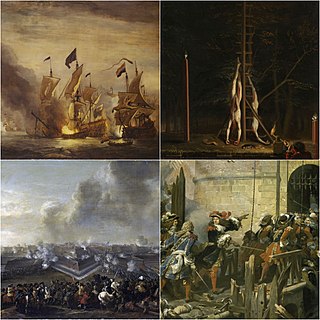
The Franco-Dutch War, also known as the Dutch War, was fought between France and the Dutch Republic, supported by its allies the Holy Roman Empire, Spain, Brandenburg-Prussia and Denmark-Norway. In its early stages, France was allied with Münster and Cologne, as well as England. The 1672 to 1674 Third Anglo-Dutch War and 1675 to 1679 Scanian War are considered related conflicts.

The Battle of Freiburg, fought over three days on 3, 5, and 9 August 1644, took place during the Thirty Years' War, near Freiburg im Breisgau, now in Baden-Württemberg. A French army of 16,000, led jointly by Condé and Turenne, sought to relieve the town, which had recently surrendered to a Bavarian force under Franz von Mercy. In what has been described as the bloodiest battle of the war, around half of the French soldiers engaged were killed or wounded, with the Bavarians losing up to a third of theirs. The French claimed victory since Mercy was forced to withdraw, but the result is disputed.
Sundgau is a geographical territory in the southern Alsace region, on the eastern edge of France. The name is derived from Alemannic German Sunt-gowe, denoting an Alemannic county in the Old High German period. The principal city and historical capital is Altkirch.

Turckheim is a commune in the Haut-Rhin department in Grand Est in north-eastern France. It lies west of Colmar, on the eastern slopes of the Vosges mountains.

The Battle of Mulhouse, also called the Battle of Alsace, which began on 7 August 1914, was the opening attack of the First World War by the French Army against the German Empire. The battle was part of a French attempt to recover the province of Alsace, which France had ceded to the new empire following its defeat in the Franco-Prussian War of 1870–1871. The French occupied Mulhouse on 8 August and were then forced out by German counter-attacks on 10 August. The French retired to Belfort, where General Louis Bonneau, the VII Corps commander, was sacked, along with the commander of the 8th Cavalry Division. Events further north led to the German XIV and XV corps being moved away from Belfort and a second French offensive by the French VII Corps, reinforced and renamed the French Army of Alsace, began on 14 August.

The Battle of Cassel, also known as the Battle of Peene, took place on 11 April 1677 during the Franco-Dutch War, near Cassel, 15 km (9 mi) west of Saint-Omer. A French army commanded by the duc de Luxembourg defeated a combined Dutch–Spanish force under William of Orange.

The Battle of Friedlingen took place on 14 October 1702, during the War of the Spanish Succession. Most of the fighting centred around Friedlingen, now a suburb of Weil am Rhein, on the border between the German state of Baden-Württemberg and Switzerland. A French force under Villars defeated an Imperial army commanded by Louis William, Margrave of Baden-Baden.
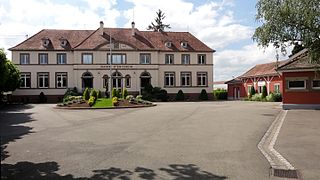
Entzheim is a commune, in the Bas-Rhin department in Grand Est in north-eastern France.

The Battle of Salzbach, or Sasbach, took place on 27 July 1675 during the Franco-Dutch War, when an Imperial army under Raimondo Montecuccoli confronted a French force commanded by Marshal Turenne. The "battle" consisted primarily of an artillery duel, during which Turenne was killed by a cannonball.
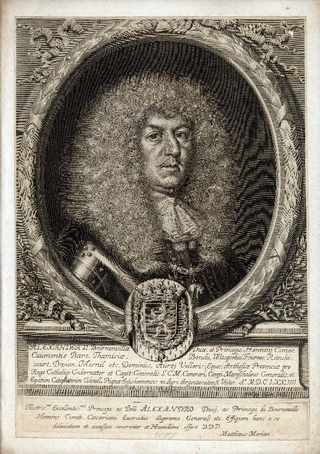
Alexander von Bournonville, Alexander de Bournonville, Alexander II Hyppolite, Prince of Bournonville and third Count of Hénin-Liétard was a Flemish military commander. He held the titles of Field Marshal of the Holy Roman Empire, Knight of the Order of the Golden Fleece, Viceroy of Catalonia (1678–1685) and Viceroy of Navarre (1686–1691).
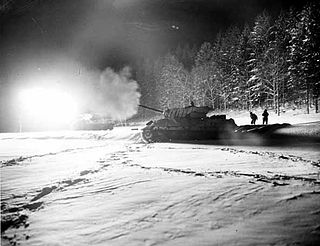
The Battle of Alsace was a military campaign between the Allies, mainly French, and the Germans in Alsace, eastern France, from 20 November 1944 to 19 March 1945. It led to the liberation of Alsace by the Allies.
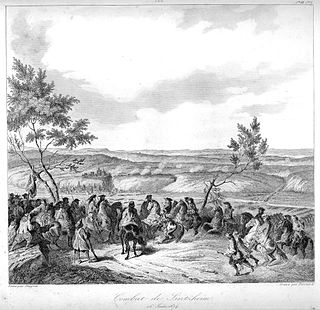
The Battle of Sinsheim took place on 16 June 1674, near Sinsheim in modern Baden-Württemberg, then in the Holy Roman Empire. Part of the 1672 to 1678 Franco-Dutch War, a French army under Marshall Turenne defeated an Imperial force led by Aeneas de Caprara.

The Battle of Entzheim took place on 4 October 1674, during the 1672 to 1678 Franco-Dutch War. It was fought near the town of Entzheim, south of Strasbourg in Alsace, between a French army under Turenne, and an Imperial force commanded by Alexander von Bournonville.
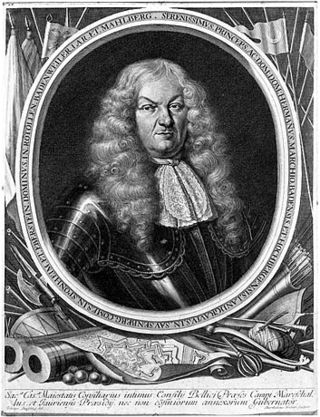
Margrave (Prince) Hermann of Baden-Baden was a general and diplomat in the imperial service. He was Field Marshal, president of the Hofkriegsrat, and the representative of the Emperor in the Perpetual Diet of Regensburg.

The Battle of Hartmannswillerkopf was a series of engagements during the First World War fought for the control of the Hartmannswillerkopf peak in Alsace in 1914 and 1915. The peak is a pyramidal rocky spur in the Vosges mountains, about 5 km (3.1 mi) north of Thann, standing at 956 m (3,136 ft) and overlooking the Alsace Plain, Rhine valley and the Black Forest in Germany. Hartmanswillerkopf was captured by the French army during the Battle of Mulhouse (7–10, 14–26 August 1914). From the vantage point, Mulhouse and the Mulhouse–Colmar railway could be seen and the French railway from Thann to Cernay and Belfort shielded from German observation.
Turenne's Winter Campaign took place during the Franco-Dutch War of 1672-78. During December 1674 and January 1675, Henri de la Tour d'Auvergne, Vicomte de Turenne, led French forces on a flank march that resulted in the defeat of an army fielded principally by the Holy Roman Empire and in that army's expulsion from Alsace.

The Battle of Altenheim took place on 1 August 1675 during the 1672-1678 Franco-Dutch War near Altenheim, in modern Baden-Württemberg. It was fought by a French army of 20,000, jointly commanded by the Marquis de Vaubrun and the Comte de Lorges, and an Imperial Army of 30,000 under Raimondo Montecuccoli.
The Battle of Ortenbach, also known as the Battle of Gengenbach, took place on 23 July 1678 during the closing stages of the 1672-1678 Franco-Dutch War, in the modern German state of Baden-Württemberg. It featured a French army commanded by François de Créquy and an Imperial force under Charles V, Duke of Lorraine.



















